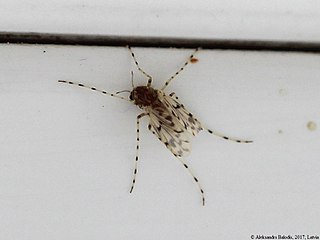
A midge is any small fly, including species in several families of non-mosquito nematoceran Diptera. Midges are found on practically every land area outside permanently arid deserts and the frigid zones. Some midges, such as many Phlebotominae and Simuliidae, are vectors of various diseases. Many others play useful roles as prey for insectivores, such as various frogs and swallows. Others are important as detritivores, and form part of various nutrient cycles. The habits of midges vary greatly from species to species, though within any particular family, midges commonly have similar ecological roles.

The Chironomidae comprise a family of nematoceran flies with a global distribution. They are closely related to the Ceratopogonidae, Simuliidae, and Thaumaleidae. Many species superficially resemble mosquitoes, but they lack the wing scales and elongated mouthparts of the Culicidae.

Metriocnemus is a genus of non-biting midges in the subfamily Orthocladiinae of the bloodworm family Chironomidae.

Tanytarsus is a large genus of non-biting midges of the tribe Tanytarsini and subfamily Chironominae of the bloodworm family (Chironomidae). The larvae of these insects occur in a wide range of freshwater habitats with some species being marine.

Chironominae is a subfamily of midges in the non-biting midge family (Chironomidae).

Glyptotendipes is a genus of non-biting midges in the subfamily Chironominae of the bloodworm family Chironomidae.
Cladopelma is a genus of non-biting midges in the subfamily Chironominae and tribe Chironomini of the bloodworm family Chironomidae. Species are distributed world-wide, with species represented in the Palaearctic, Nearctic, Neotropical, Afrotropical, Sino-Indian, and Austroasian regions.
Xenochironomus is a genus of European non-biting midges in the subfamily Chironominae of the bloodworm family Chironomidae.

Tanytarsini is a tribe of midges in the non-biting midge family (Chironomidae).

Tanypodinae is a subfamily of midges in the non-biting midge family (Chironomidae). The larvae are generally carnivorous and their mouthparts are adapted for predation on small invertebrates although 1st and 2nd instar larvae also feed on algae.
Clinotanypodini is a tribe of midges in the non-biting midge family (Chironomidae). It was traditionally known as Coelotanypodini Fittkau, 1962, but sources such as Fauna Europaea now recognize Clinotanypi Lipina, 1928 as having priority.
Procladiini is a tribe of midges in the non-biting midge family (Chironomidae).
Tanypodini is a tribe of midges in the non-biting midge family (Chironomidae).
Macropelopiini is a tribe of midges in the non-biting midge family (Chironomidae).
Pentaneurini is a tribe of midges in the non-biting midge family (Chironomidae).

Prodiamesinae is a subfamily of midges in the non-biting midge family (Chironomidae).

Diamesinae is a subfamily of midges in the non-biting midge family (Chironomidae).
Diamesini is a tribe of midges in the non-biting midge family (Chironomidae).
Syndiamesa is a genus of non-biting midges in the subfamily Diamesinae of the bloodworm family Chironomidae.

Potthastia is a genus of non-biting midges in the subfamily Diamesinae of the bloodworm family Chironomidae.








